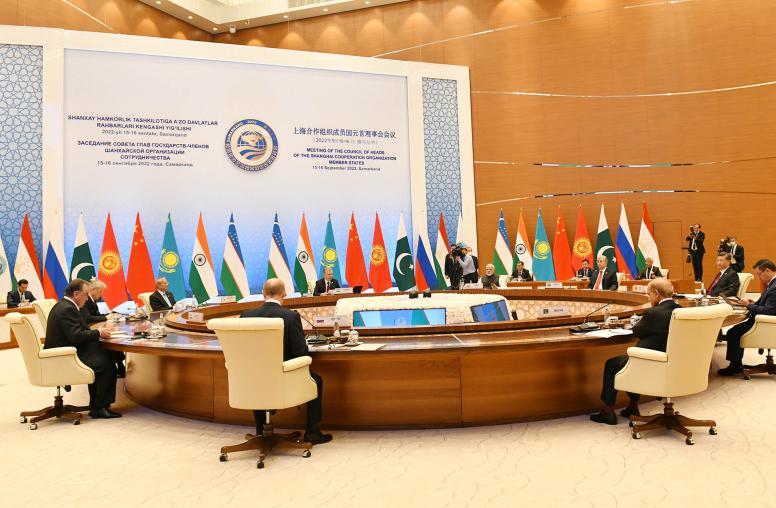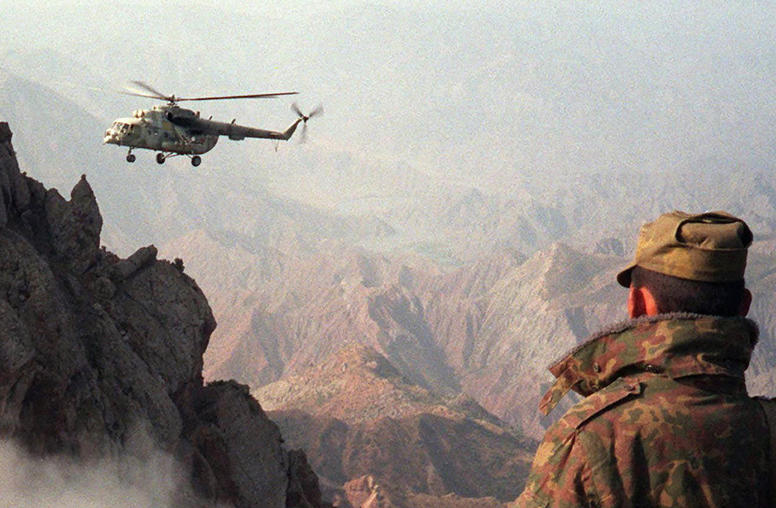Russia’s Ukraine War Weighs Heavily on Tajikistan
The Tajik government should focus on securing greater domestic legitimacy as Russia remains mired in Ukraine.
The Russian invasion of Ukraine has left the five republics of Central Asia in a bind, but none more so than Tajikistan, a fragile country that depends on Russian troops and remittances for stability. As former Soviet republics, Central Asian states all enjoy special relations with Moscow and are considered traditional allies of the Russian Federation. The invasion of Ukraine — another former Soviet republic — raises urgent questions for Tajikistan about how to meet Russian expectations of support from Dushanbe in the face of global outrage and condemnation.

Tajikistan has a particularly difficult balancing act to perform because it hosts an estimated 7,000 Russian troops and receives Russian security and economic assistance, among other forms of support. With Russia weakened by U.S. and allies’ sanctions, Tajikistan and its ruling elites will suffer because of the country’s intertwined economic, political and security relations with Russia. Tightening economic conditions will push the top echelon of the ruling elite to grab whatever resources are left and squeeze out others. In this scenario, less and less benefit will trickle down to the general public fostering further discontent. A robust process of political and economic reform within the country along with a foreign policy that emphasizes strengthening regional cooperation and economic integration may provide the country a way out of its current predicament.
Tajikistan’s Domestic Vulnerability
Tajikistan is the poorest Central Asian country and is more vulnerable to the impact of Western sanctions on Russia because of its economic ties with Moscow and its excessive dependence on Russian security assistance since the Tajik civil war. Russia is the biggest security and trading partner of Tajikistan, which is also highly dependent on remittance money from its labor migrants working in Russia.
According to a March World Bank report, Tajikistan will face a 22 percent fall in remittances against a previously forecasted rise of two percent. This is a significant decline for the country of nine million people where remittance make up 26.7 percent of the GDP. Labor migrants, including more than 1.5 million Tajiks, will be the first to lose their jobs in a weakened Russian economy and tight job market. Additionally, restrictions on sending remittance back home coupled with Russian authorities’ increased harassment of labor migrants has stirred up anti-Russian sentiments and widened the trust gap between the population and the government of Tajik President Emomali Rahmon, who is widely seen as a Kremlin ally.
At the same time, Tajikistan is highly fragile due to domestic problems. Freedom House rates the country low on democracy and inclusion scores. The legacy of the 1992-1997 civil war and an ill-defined post-peace accord political process continue to overshadow Tajik politics. Rahmon’s political party, the People’s Democratic Party, has been in power since independence, dominating all aspects of political life. While Rahmon’s government has established a firm grip on political power by suppressing most opposition groups, the regime’s credibility and popular legitimacy are increasingly questioned among opposition groups, civil society, academics and some in the general public. Civil Society and media groups are tightly controlled by the state and largely depend on government funding and approval to operate. Religious practices and communal worship are also closely monitored by state agencies that regulate laws on religious freedom and worship. Similarly, market and economic decisions are totally dominated by the ruling elites with most businesses either run directly by the government or owned by the few individuals and families in power.
While building a broader base of support is usually the recommendation for a fragile government, Tajikistan’s reactions to increasing pressure has been to narrow it. The Tajik government is consistently pursuing a policy of political exclusion concentrating power in the hands of the president, his family and friends. Such exclusive policies have intensified key long-standing fractures along lines of clan, geography, politics and access to power and resources in the country.
While the president and his Kulabi clan dominate power, the Islamist opposition still enjoy a certain degree of support among the population in their former strongholds of Pamirs and Khatlon. The Gorno-Badakhshan Autonomous Oblast (GBAO) has witnessed periodic unrest and protest since 2012. The most recent protest in November 2021, following the killing of a young protester by security forces, led to widespread unrest and social resentment in the region.
Additionally, Tajikistan has several significant fault lines including the border with Afghanistan and relations with Taliban in the south and with Kyrgyzstan in the north, the legacy of the civil war and manipulation of political power, increasing dependence on foreign debts particularly from China, and aging economic development infrastructure. The Tajik economy was hit hard by the COVID-19 pandemic and with GDP declining significantly over the last couple of years. As a consequence of the sanctions on Russia and declining inflow of remittances, prices of basic commodities such as flour, sugar and gas have risen significantly with the value of the national currency, the somoni, on a steep decline against the dollar and other hard currencies.
Tajikistan has also accumulated a hefty $3.2 billion in foreign debt, amounting to 40 percent of the country’s GDP. China is the biggest creditor with a loan of more than $1.2 billion. Though Tajikistan received concessions from China to temporarily suspend debt repayment due to the COVID-19 pandemic, it is not clear when Tajikistan must resume payment. Most Chinese debts are for huge infrastructure projects funded under China’s Belt and Road Initiative that neither yield any return in the short-term nor typically benefit the poor and marginalized segments of society. Chinese loans have mainly benefited Tajik ruling elites and further eroded the country’s sovereignty through mining concessions and permission granted to the People’s Republic Army of China to establish military outposts in the mountainous Pamir region of Tajikistan.
Tajikistan in a Tough Neighborhood
Meanwhile, the situation in Afghanistan continues to pose threats to Tajikistan’s and other neighboring Central Asian states’ security. Spillover effects of the Taliban victory — including infiltration by violent Islamic extremist groups, drugs and organized crime, and the possibility of a full-blown Afghan civil war — are major concerns. Tajikistan is particularly anxious about the security of its southern border with Afghanistan, an 850-mile line that is stretched over the Pamir mountains and some inhospitable terrains. Tajikistan is the only Central Asian country that has objected to the Taliban takeover, calling for a more inclusive government in Afghanistan while providing shelter to several former Afghan government leaders, including those from the former Northern Alliance.
Though Tajikistan is a member of the Russia-led Collective Security Treaty Organization, and heavily relies on Russian military support — particularly the Russian army’s 201-Rifle division — for securing its southern border, Russia’s entanglement in Ukraine and its military’s poor performance may force Moscow to change its security calculations. Any significant change in the posture and number of the 201-Rifle Division will certainly affect Tajikistan’s security and may even create opportunities for the opposition to challenge the writ of Dushanbe in bordering communities, particularly in the GBAO region. Perhaps worst of all, the Taliban may allow or turn a blind eye to the activities of Islamist extremist groups with roots in Central Asia such as the Islamic Jihad Union (IJU) and Jamaat Ansarullah, who could infiltrate the border and challenge peace and security in Tajikistan. These groups along with an array of other transnational Islamist extremist organizations, such as ISIS-K and al-Qaida, are regrouping in Afghanistan after the pull out of the U.S. and NATO troops.
In addition to the tense security environment on its southern border with Afghanistan, the conflict and recurrent border skirmishes with Kyrgyzstan over land and water in the Ferghana Valley have strained relations between the two states and created additional economic and security challenges. The border conflict in April 2021 left dozens dead from both sides and resulted in reciprocal travel restrictions on citizens of the two countries.
A Pivot for Tajikistan?
As the most vulnerable and poorest Central Asian countries, Tajikistan must be prepared to face the consequences of the challenges posed by Russia’s war in Ukraine. In his recent Ramadan speech, Rahmon hinted at a gloomy period of unpredictability but fell short of proposing a solution on his government plans to respond. As argued by a Tajik journalist in exile, Tajikistan can seize on Russia’s miscalculations as an opportunity to reconsider its relationships and embark on a “vigorous” path of political and economic reform.
Rather than consolidate power among a narrow group of family and clan, the government of President Rahmon would be wise to replace Russian support with greater domestic legitimacy. Governance and economic reforms, including respect for the rule of law and civil liberties, will ensure greater participation of the people, increase opportunities for constructive dialogues and reduce social tension and mistrust of the government. It will also encourage international cooperation for more robust development and financial assistance and provide an enabling environment for foreign investment. Tajikistan will also benefit from improved economic integration and political and security cooperation with neighboring Central Asian states.
In particular, Tajikistan can leverage the historical and cultural bonds that it shares with its neighboring states for geopolitical benefits, economic development and strengthen security cooperation. At a time when Tajikistan faces serious economic and security perils, reforming the country’s systems of governance and economic management coupled with a foreign policy that emphasizes regional cooperation and integration offers opportunities that must not be missed.
This requires a clear commitment by the government of Tajikistan. And the international community can help. In particular, the United States and the European Union should consider extending increased economic partnership and investment opportunities to support the reform process and alleviate the pain caused by the consequences of Russia’s war in Ukraine. Yet, any new assistance package and investment initiative should be tied to progress on political and economic reforms and mechanisms that ensure accountability and transparency in the process.



